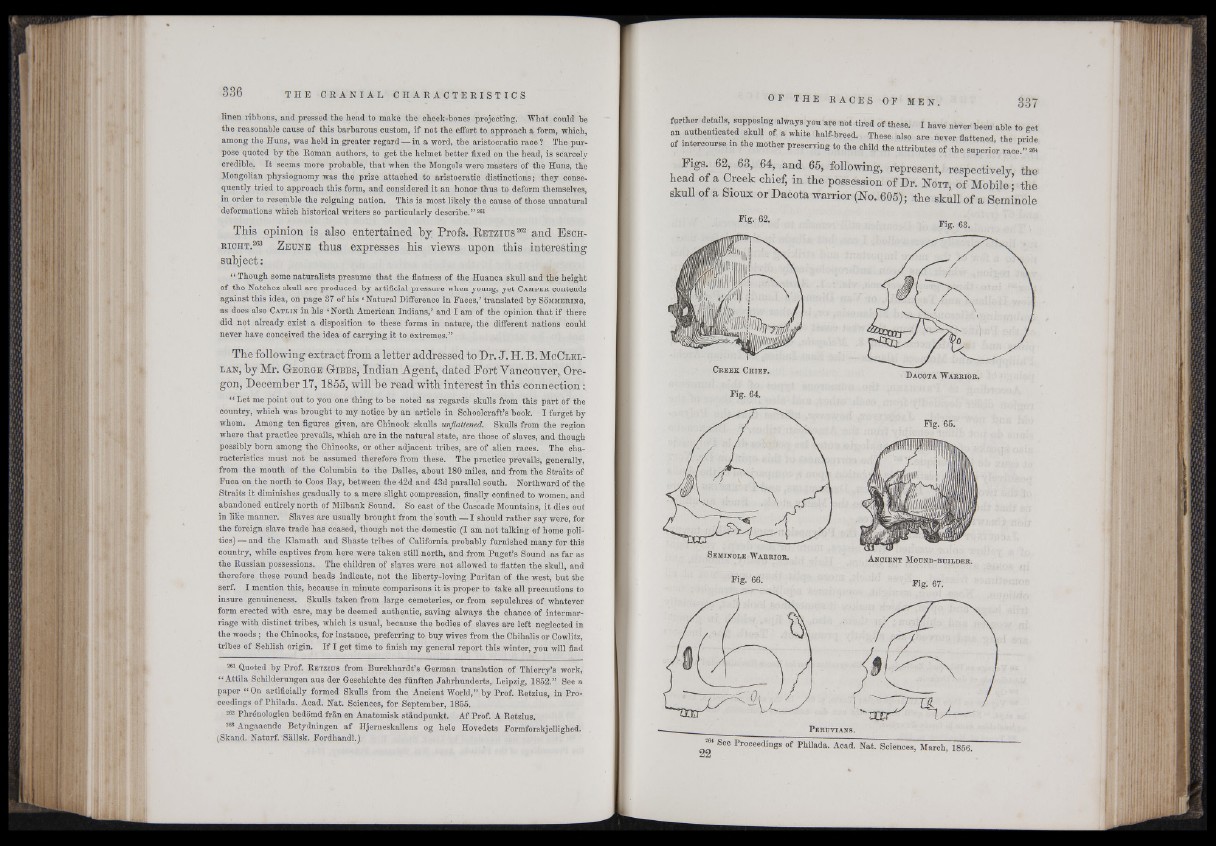
linen ribbons, and pressed the head to make the cheek-bones projecting. What could be
the reasonable cause of this barbarous custom, if not the effort to approach a form, which,
among the Huns, was held in greater regard— in a word, the aristocratic race? The purpose
quoted by the Roman authors, to get the helmet better fixed on the head, is scarcely
credible. It seems more probable, that when the Mongols were masters of the Huns, the
Mongolian physiognomy was the prize attached to aristocratic distinctions; they consequently
tried to approach this form, and considered it an honor thus to deform themselves,
in order to resemble the reigning nation. This is most likely the cause of those unnatural
deformations which historical writers so particularly describe.” 261
This opinion is also entertained by. Profs. R e t z i u s 262 and E s c h -
r i c h t .263 Z e u n e thus expresses his views upon this interesting
subject:
“ Though some naturalists presume that the flatness of the Huanca skull and the height
of the Natchez skull are produced by artificial pressure when young, yet C a m p e r contends
against this idea, on page 37 of his ‘Natural Difference in Faces,’ translated by S om m e r in g ,
as does also Ca t l in in his ‘North American Indians,’ and I am of the opinion that if there
did not already exist a disposition to these forms in nature, the different nations could
never have conceived the idea of carrying it to extremes.”
The following extract from a letter addressed to Dr. J. H. B. M cClell
a n , by Mr. G eorge G ib b s , Indian Agent, dated Port Vancouver, Oregon,
December 17,1855, will be read with interest in this connection:
“ Let me point out to you one thing to be noted as regards Bkulls from this part of the
country, which was brought to my notice by an article in Schoolcraft’s hook. I forget by
whom. Among ten figures given, are Chinook skulls unflattened. Skulls from the region
where that practice prevails, which are in the natural state, are those of slaves, and though
possibly horn among the Chinooks, or other adjacent tribes, are of alien races. The characteristics
must not be assumed therefore from these. The practice prevails, generally,
from the mouth of the Columbia to the Dalles, about 180 miles, and from the Straits of
Fuca on the north to Coos Bay, between the 42d and 43d parallel south. Northward of the
Straits it diminishes gradually to a mere slight compression, finally confined to women, and
abandoned entirely north of Milbank Sound. So east of the Cascade Mountains, it dies out
in like manner. Slaves are usually brought from the'south — I should rather say were, for
the foreign slave trade has ceased, though not the domestic (I am not talking of home politics)
— and the Klamath and Shaste tribes of California probably furnished many for this
country, while captives from here were taken still north, and from Puget’s Sound as far as
the Russian possessions. The children of slaves were not allowed to flatten the skull, and
therefore these round heads indicate, not the liberty-loving Puritan of the west, but the
serf. I mention this, because in minute comparisons it is proper to take all precautions to
insure genuineness. Skulls taken from large cemeteries, or from sepulchres of whatever
form erected with care, may be deemed authentic, saving always the chance of intermarriage
with distinct tribes, which is usual, because the bodies of slaves are left neglected in
the woods; the Chinooks, for instance, preferring to buy wives from the Chihalis or Cowlitz,
tribes of Sehlish origin. If I get time to finish my general report this winter, you will find
261 Quoted by Prof. R e t z iu s from Burckhardt’s German translation of Thierry’s work,
“ Attila Schilderungen aus der Geschichte des funften Jahrhunderts, Leipzig, 1852.” See a
paper “ On artificially formed Skulls from the Ancient World,” by Prof. Retzius, in Proceedings
of Philada. Acad. Nat. Sciences, for September, 1855.
262 Phrdnologien bedomd fr&n en Anatomisk st&ndpunkt. Af Prof. A Retzius.
268 Angaaende Betydningen af Hjemeskallens og hele Hovedets Formforskjellighed.
(Skand. Naturf. Sallsk. Fordhandl.)
further details supposing always you are not tired of these. I have never been able to get
an authenticated skull of a white half-breed. These also are never flattened, the pride
of intercourse in the mother preserving to the child the attributes of the superior race ” 284
Figs. 62, 63 64, and 65, following, represent, respectively, the
head of a Creek chief, in the possession of Dr. N ott of Mobile • the
skull of a Sioux or Dacota warrior (No. 605); the skull of a Seminole
Flg' 62‘ Fig. 63.
P e r u v ia n s .
Cr e e k Ch i e f .
Fig. 64.
S e m i n o l e W a r r i o r .
Fig. 66.
D a c o t a W a r r io r .
Fig. 65.
A n c ie n t Mo u n d - b u il d e r .
Fig. 67.
284 See Proceedings of Philada. Acad. Nat. Sciences, March, 1856. ¿A